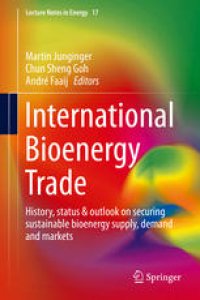
Ebook: International Bioenergy Trade: History, status & outlook on securing sustainable bioenergy supply, demand and markets
- Genre: Technique // Energy
- Tags: Energy Policy Economics and Management, Renewable and Green Energy, Environmental Economics, Energy Economics, Sustainable Development
- Series: Lecture Notes in Energy 17
- Year: 2014
- Publisher: Springer Netherlands
- Edition: 1
- Language: English
- pdf
The trade of global bioenergy commodities, such as ethanol, biodiesel and wood pellets has been growing exponentially in the past decade, and have by 2013 reached true “commodity” volumes, i.e. tens of millions of tonnes traded each year, and billions (both in US$/€) of annual turnover.
IEA Bioenergy Task 40 was founded in 2004 and is now in its 4th triennium. For the past 9 years, task 40 has monitored the developments in international bioenergy trade, including the organization of about 20 workshops on trade-related topics, and the publication of over 100 studies, country reports, newsletters, etc. The amount of material produced over the years and insights gained in how biomass markets and international trade of biomass and biofuels has developed is impressive. Besides that the group has produced overviews and insights, also a large amount of practical experience has been brought together in what works and what doesn’t. Last but not least, based on all this, there are clear(er) views on how to proceed to build working sustainable international biomass markets in the future. This book compiles those lessons and insights into an easily accessible book publication.
The trade of global bioenergy commodities, such as ethanol, biodiesel and wood pellets has been growing exponentially in the past decade, and have by 2013 reached true “commodity” volumes, i.e. tens of millions of tonnes traded each year, and billions (both in US$/€) of annual turnover.
IEA Bioenergy Task 40 was founded in 2004 and is now in its 4th triennium. For the past 9 years, task 40 has monitored the developments in international bioenergy trade, including the organization of about 20 workshops on trade-related topics, and the publication of over 100 studies, country reports, newsletters, etc. The amount of material produced over the years and insights gained in how biomass markets and international trade of biomass and biofuels has developed is impressive. Besides that the group has produced overviews and insights, also a large amount of practical experience has been brought together in what works and what doesn’t. Last but not least, based on all this, there are clear(er) views on how to proceed to build working sustainable international biomass markets in the future. This book compiles those lessons and insights into an easily accessible book publication.